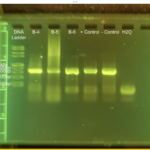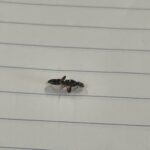Sample information |
|
| Picture |

|
|---|---|
| Location | |
| Collection date | 09/22/2024 |
| Captive / Cultivated? | Wild-caught |
| Group | Edmund Burke School |
| Observations | This arthropod seems to be a small moth. It was quite small, but when it was flying around, it had a larger appearance. I was able to catch it right after it died. I caught it in a bedroom in a house. It was a very bright space, so it makes sense that the moth would be attracted to the light. It was an urban environment, 75f, and the season was fall. |
| Putative identification | Arthropoda Insecta Lepidoptera |
Methods |
|
| Extraction kit | DNeasy (Qiagen) |
| DNA extraction location | Whole arthropod |
| Single or Duplex PCR | Single Reaction |
| Gel electrophoresis system | MiniOne |
| Buffer | TBE |
| DNA stain | GelGreen |
| Gel images |


|
| Protocol notes | DNA Extraction
PCR”:
Gel electrophoresis, Arthropod CO1
Gel electrophoresis, Wolbachia
|
Results |
|
| Wolbachia presence | Yes |
| Confidence level | High |
| Explanation of confidence level | B6 is a clear outlier to all the other arthropods. There is a clear, glowing box under B6. There were no errors in this gel. The positive control came back positive, and the negative control was negative. We know that the gel was flawless, but the pipette tips were not changed for B2, B3, B4, B5, and B6, so there may have been some contamination; however, its effects were minuscule since the gels ran well. |
| Wolbachia 16S sequence | Download FASTA
Download AB1
NNNNNNNNNNnGTTGGGTTAAGTCCCGCAACGAGCGCAACCCTCATCCTTAGTTACCATCAGGTAATGCTGGGGACTTTA AGGAAACTGCCAGTGATAAACTGGAGGAAGGTGGGGATGATGTCAAGTCATCATGGCCCTTATGGAGTGGGCTACACACG TGCTACAATGGTGGCTACAATGGGCTGCAAAGTCGCGAGGCTAAGCTAATCCCTTAAAAGCCATCTCAGTTCGGATTGTA CTCTGCAACTCGAGTGCATGAAGTTGGAATCGCTAGTAATCGTGGATCAGCACGCCACGGTGAATACGTTCTCGGGTCTT GTACACACTGCCCGTCACnN
BLAST at The Wolbachia Project BLAST at NCBI
|
| Arthropod COI sequence | Download FASTA
Download AB1
nAGTAGGAACATCCCTAAGATTACTAATTCGTGCTGAATTAGGAACCCCCGGATCTTTAATTGGTGATGATCAAATTTAT AATACTATTGTTACAGCTCATGCATTTATTATAATTTTTTTTATAGTAATACCAATTATAATTGGTGGATTTGGAAATTG ATTAGTTCCATTAATACTAGGAGCACCTGATATAGCATTCCCACGAATAAATAATATAAGATTTTGATTATTGCCTCCCT CTTTAACCTTATTAATTTCTAGAAGAATTGTAGAAAATGGGGCTGGAACAGGATGAACAGTATACCCCCCCCTTTCATCT AATATTGCTCACAGAGGAAGATCTGTAGACTTAGCTATTTTTTCCCTACACTTAGCAGGAATTTCTTCAATTCTAGGAGC AATTAATTTTATTACAACTATTATTAACATACGAATTAATGGATTATCTTTTGATCAAATACCTTTATTTGTTTGATCTG TTGGAATTACAGCTTTACTTCTTCTCCTATCATTACCAGTATTAGCTGGAGCTATTACTATATTACTTACTGATCGAAAT CTTAATACTTCTTTTTTn
BLAST at The Wolbachia Project BLAST at NCBI
|
| Summary | The Lepidoptera was found to be postive for Wolbachia. |
 European Paper Wasp
European Paper Wasp Woodworm Ant
Woodworm Ant